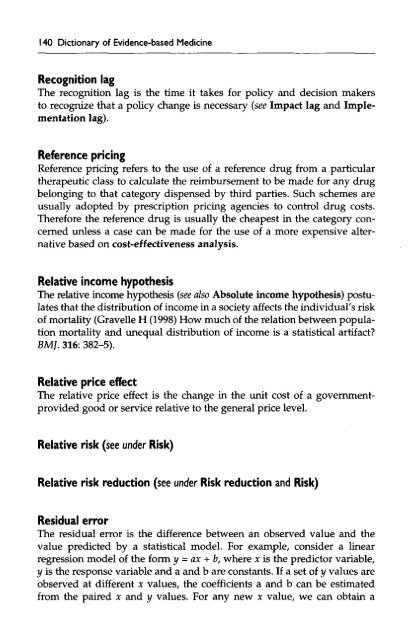Dictionary of Evidence-based Medicine.pdf
Dictionary of Evidence-based Medicine.pdf
Dictionary of Evidence-based Medicine.pdf
Create successful ePaper yourself
Turn your PDF publications into a flip-book with our unique Google optimized e-Paper software.
140 <strong>Dictionary</strong> <strong>of</strong> <strong>Evidence</strong>-<strong>based</strong> <strong>Medicine</strong><br />
Recognition lag<br />
The recognition lag is the time it takes for policy and decision makers<br />
to recognize that a policy change is necessary (see Impact lag and Implementation<br />
lag).<br />
Reference pricing<br />
Reference pricing refers to the use <strong>of</strong> a reference drug from a particular<br />
therapeutic class to calculate the reimbursement to be made for any drug<br />
belonging to that category dispensed by third parties. Such schemes are<br />
usually adopted by prescription pricing agencies to control drug costs.<br />
Therefore the reference drug is usually the cheapest in the category concerned<br />
unless a case can be made for the use <strong>of</strong> a more expensive alternative<br />
<strong>based</strong> on cost-effectiveness analysis.<br />
Relative income hypothesis<br />
The relative income hypothesis (see also Absolute income hypothesis) postulates<br />
that the distribution <strong>of</strong> income in a society affects the individual's risk<br />
<strong>of</strong> mortality (Gravelle H (1998) How much <strong>of</strong> the relation between population<br />
mortality and unequal distribution <strong>of</strong> income is a statistical artifact<br />
BMJ. 316: 382-5).<br />
Relative price effect<br />
The relative price effect is the change in the unit cost <strong>of</strong> a governmentprovided<br />
good or service relative to the general price level.<br />
Relative risk (see under Risk)<br />
Relative risk reduction (see under Risk reduction and Risk)<br />
Residual error<br />
The residual error is the difference between an observed value and the<br />
value predicted by a statistical model. For example, consider a linear<br />
regression model <strong>of</strong> the form y = ax + b, where x is the predictor variable,<br />
y is the response variable and a and b are constants. If a set <strong>of</strong> y values are<br />
observed at different x values, the coefficients a and b can be estimated<br />
from the paired x and y values. For any new x value, we can obtain a










